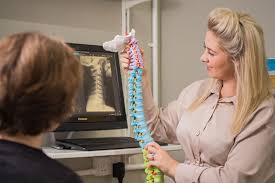Key Facts About Chiropractors
History of chiropractic
The chiropractic profession was established long ago in 1895 by Daniel David Palmer who realized that though chiropractic techniques had been used for thousands of years, no one had looked at the rationale to explain their effects.
He performed his first adjustment as an established chiropractor in 1895, improving the hearing of a deaf janitor who had suffered from back pain for over 17 years.
The profession became licensed, and today there are more than 70,000 active chiropractic licenses in the United States!

Key Facts and Figures About the Chiropractic Profession
Chiropractic is a health care profession that focuses on disorders of the musculoskeletal system and the nervous system, and the effects of these disorders on general health. These disorders include, but are not limited to: back pain, neck pain, pain in the joints of the arms or legs, and headaches. Doctors of chiropractic (DCs) practice a conservative approach to health care that includes patient examination, diagnosis and treatment. DCs have broad diagnostic skills and are also trained to recommend therapeutic and rehabilitative exercises, as well as to provide nutritional, lifestyle and dietary counseling.
- There are more than 70,000 chiropractors in the United States who are required to pass a series of four national board exams and be state licensed. Roughly another 3,000 chiropractors work in academic and management roles.
- There are approximately 10,000 chiropractic students in 18 nationally accredited, chiropractic doctoral graduate education programs across the United States with 2,500 chiropractors entering the workforce every year.
- An estimated 40,000 chiropractic assistants (CAs)are in clinical and business management roles for chiropractic practices across the United States.
- It is estimated that chiropractors treat more than 35 million Americans (adults and children) annually.
- Chiropractors are educated in nationally accredited, four-year doctoral graduate school programs through a curriculum that includes a minimum of 4,200 hours of classroom, laboratory and clinical internship, with the average DC program equivalent in classroom hours to allopathic (MD) and osteopathic (DO) medical schools.
- Chiropractors are designated as physician-level providers in the vast majority of states and federal Medicare program. The essential services provided by chiropractors are also available in federal health delivery systems, including those administered by Medicaid, the U.S. Departments of Veterans Affairs and Defense, Federal Employees Health Benefits Program, Federal Workers’ Compensation, and all state workers’ compensation programs.

What Disorders Do Chiropractors Treat?
Chiropractors diagnose and treat many different spinal disorders that cause musculoskeletal or nerve pain. Similar to other types of doctors, a chiropractor performs a physical and neurological examination as part of his or her process of making an accurate diagnosis. X-rays or CT scan studies may be ordered to confirm your diagnosis. This article highlights several spine-related problems that may be evaluated and treated by chiropractic care.
Back sprains and strains are experienced by approximately three out of four adults. Sprains are caused when ligaments—the tough bands of tissue that hold bones together—become overstretched or torn. Strains involve a muscle and/or a tendon. Either one can occur when you lift too much weight, play a strenuous sport, or even bend or twist improperly during regular activities during the day. The pain may be aching, burning, stabbing, tingling, sharp, or dul
Cervicogenic headaches are caused by referred neck pain. The pain from this type of headache is usually felt at the back of the head, in the temples, and/or behind the eyes. A cervicogenic headache may be mistaken for migraines or cluster headaches.
Coccydynia is pain that develops in the spine’s tailbone. Some people who fall down or who ride a bike for a long time may develop coccydynia, which can get worse when sitting. Sometimes the pain begins without any known cause.
Degenerative disc disease (DDD) is usually associated with aging. As you become older, your intervertebral discs— the pillow-like cushions between your vertebrae—can degenerate or break down due to years of strain, overuse, or misuse. The discs may lose flexibility, elasticity, and shock absorption. They also become thinner as they dehydrate.
Herniated disc usually occurs in the neck or low back. A herniated disc can cause pain when the outer ring (annulus) or interior matter (nucleus pulposus) presses on a nearby nerve root.
Myofascial pain is a chronic pain disorder where pressure on sensitive points in your muscles—called trigger points—can cause deep, aching pain in seemingly unrelated parts of your body. This is known as referred pain. Sometimes myofascial pain feels like a “knot” in your muscle, and occurs after a muscle is used repeated

A CHIROPRACTOR OR A MASSAGE THERAPIST: WHAT’S THE DIFFERENCE?
What most chiropractors and massage therapists have in familiar is; they use their hands to treat you, both of the treatments have immediate effect and they provide drug-free alternatives to pain management.
What differs them from one another is that chiropractors are focusing on manipulating hard tissues (your bones), while massage therapists work on your muscles, ligaments, and tendons.
The main goal of a chiropractor is to release subluxations in the spine to make sure that your body and your nervous system are at their optimal level. Massage therapist is focusing on treating muscular conditions only and they aim to relieve muscle pain, tension, and stiffness.
Is chiropractic subluxation theory really so different? How many chiropractors even believe it?
I’ve heard many chiropractors scoff dismissively that “most chiropractors don’t believe subluxation theory anymore anyway.” Even if they are right, it admits that the profession is still burdened with a faction that does believe. But it’s not that small a faction. In fact, it’s probably a large one, between those who vocally defend the original, untainted theory and those who avoid the term because of its baggage but still believe it quietly, or who reject the most extreme versions but are still deeply influenced by the theory.
Openly defending the original chiropractic subluxation theory are many chiropractors who often call themselves “straight” chiropractors, meaning “pure.” Straights subscribe to the full, traditional “subluxation theory” more or less exactly as formulated more than a hundred years ago, they practice “subluxation-based chiropractic,” and they definitely think of a chiropractic subluxation as being fundamentally different than how a doctor would define subluxation. They believe that subluxations cause not only back and neck pain, but practically any health problem, simply by impinging or irritating spinal nerve roots.